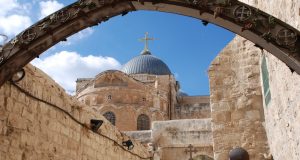Book Review by Rev Barry Allen
“Anatomy of a Revived Church: Seven Findings about How Congregations Avoided Death” by Thom Rainer
I am not very good at writing reviews as such, but I want to record how my experience in ministry shows the accuracy and worth of the book, Anatomy of a Revived Church. I hope this will encourage others to read the book and pray that it will enthuse the reader to put into practice the suggestions in its pages.
I literally read this book in two sessions. I found it so encouraging that I could not put it down – I found it encouraging for the very fact that I know from experience that the guidelines and suggestions of areas needing change outlined in the book actually work.
I especially found Chapter 1. Accepting Responsibility, 2. Overcoming the traps of traditions, 4. Committing to Powerful Prayer (especially this one), and 5. Dealing with Toxins is very, very helpful for actually confirming what I have majored in in my pastoral ministry. And had I more space and time, I could fill out page and verse what I found worked in reviving a church – I have been blessed to have experienced it in three parishes.
At the outset, I want to acknowledge, as Rainer asserts on p.69:
“It is God who revitalizes churches. If we truly want to see his work in our churches, we must turn to him in prayer”.
All my muddling steps, which proved to be the right ones, were certainly done under the guidance of the Holy Spirit.
Here I also include a passage from Wayne McHugh’s review of the book because it is so true in not only getting to the heart of the book, but also of what is needed in the UCA. It actually highlights the “pastor silver bullet”.
“One of the sub-plots that carries through the whole book resonates strongly with the Uniting Church – the minister cannot save the local church; it is a ministry of all the people. The journey of revitalisation will almost certainly move from a minister-centric local practice, intentionally and persistently, towards a shared ministry of the whole congregation. In this respect, Rainer is presenting something we should already know a great deal better than we often practice.”
The sub-plot of the Revived Church, as stated above, is a reflection on the Bible passage and theological thought I have endeavoured to practise throughout my entire ministry. Especially Ephesians 4:11-13 (as Rainer points out on p.34) and the theological concept of the Priesthood of all believers. My motto has always been “I intend to work myself out of a job”.
The congregations I served are Drummoyne, an inner Sydney congregation from 1975 -1980, Camden on the outskirts south of Sydney (now part of the Greater Sydney Metropolitan area) from 1981-1990 and Pine Rivers in the north of Brisbane 1991-2007. At the time of my taking up each position they were all facing very different difficulties.
Drummoyne, which had been a strong, vibrant Methodist Congregation, was in its death throes, with an average attendance of around 15 retired individuals. I was told that at its peak there had been over 200 in the Sunday School. When I arrived, as a theological student my remuneration was $15 per week and the free rent of the manse. This remained unchanged until after I was ordained in November 1979, and I stayed on for another year on 4 days while continuing my studies at Macquarie University.
When I arrived, the church program consisted of a Sunday service and a weekly indoor bowls club. When I left at the end of 1980, there was a full program of congregational life (averaging 80 in attendance at worship), and they called a full-time ordained minister to follow me. Having read Rainer’s book, I realised that what had happened to revise Drummoyne was as he had clearly spelt out.
I arrived at Camden in January 1981 with the congregation in rapid decline. What had been a vibrant Methodist Circuit (the reward appointment for senior Methodist ministers) now had a maximum of 50 in the morning congregation and 25 at night and was still declining with a congregation in full battle mode within its membership. Before accepting the call, I had been well informed of the issues causing the exodus and the infighting.
When I left in January 1991, there were over 600 adults connected to the congregation, with an average of 500 attending over three services. The church had been through a major renovation, turning a typical 140-seat (including the choir stalls) Methodist building into a modern 350-seat auditorium, which had been opened debt-free. A large block of land had been purchased in the neighbouring town of Narellan, which had been earmarked for major development. The house next door to the Camden church had also been purchased to enable further expansion when needed.
How had this been achieved? I just flew by the seat of my pants, guided by circumstance and the Holy Spirit. Trying new things, seeing what worked and what didn’t, then going with the things that worked and abandoning those that did not.
Then, just like at Drummoyne, I saw the affirmation of what had been achieved by reading Rainer’s book.
Having been sent on my way by the Presbytery (and I now acknowledge the Presbytery got it right where God’s will was concerned), I arrived in Pine Rivers in February 1991, an angry person being where I knew with certainty God wanted me to be, but not wanting to be there. After 18 months, I actually stood up and apologised to the congregation for being so difficult to get on with and asked if we could start again, and they were gracious to agree to that.
Pine Rivers, like Camden, was in turmoil. There was strong disagreement within their ranks and also with the Presbytery. Members were leaving. The problem was that the leadership had proposed a congregational merger. Three of the five congregations that made up the parish had agreed to come together and form a Regional Congregation on a large block of land they had been given at Kallangur. Without going into detail here, it quickly became apparent that even though the three congregations had voted to come together, not all members were actually in favour, and they made it known to the Presbytery. Presbytery, in return, only agreed to a very limited change within the parish. Those in favour of leadership in the congregation believed that God’s will was all or nothing. So when I arrived, it was a stalemate.
I developed a good working relationship with the new Presbytery Minister, who started about the same time as I did (and who incidentally strongly supported the concept of Regional Congregations), and we agreed to pull together to make the vision a reality. But when we actually began to move the vision from theory to practice, there was a negative reaction by all who had been opposed and who then voted with their feet. The result was that what had been a potential congregation of around 250 now numbered around 80. After growing it back to about 130, there was another setback when about 30 of those who had been the movers and shakers of the vision, our strongest leaders and givers, decided that the direction we were heading, congregational life-wise, was not what they envisaged. So, in a Sunday service, I called them out, prayed over and for them and set them free to go in the direction they believed God was leading them. Today the Vineyard Congregation in the adjoining suburb is a great witness to the Gospel. This again left a much-diminished Pine Rivers Parish with about 100 members, but on the plus side, 100 were very committed to the vision and determined to see it completed.
When I retired in June 2007, a 350-seat auditorium with a good suite of ancillary buildings had been completed and opened debt-free. There was a staff of four full-time and four part-time in ministry and ancillary positions. There were also two workers paid by the government on job seeker payments. The number of adults connected to the congregation, like Camden, was somewhere around 600, with an average attendance of 550 each Sunday. The surprise was that the evening congregation was always well in excess of 200, many of them were under the age of 25, thanks to the work of a great Youth Worker (whom I supported but did not micro-manage). Around 20 were baptised by full immersion in my last two years.
At the risk of sounding repetitive, having read Rainer’s book, I discovered that, either fully or partially, I had practised his seven findings in my ministry experience and seen those congregations revived as a result.
In closing, can I share a word of warning? If any church leader wants to revive a congregation, you first need to count the cost, the plus and minus, of the effort. No one wants to see the UCA totally revived more than I do, however as Rainer alludes to right through the book, nothing stifles growth in a congregation more than the fear of change. Any growth brings change, and the traditional Gatekeepers and other leaders fear losing their positions of control, and they will do what they can to oppose it. The spirit of the evil one will do all possible to disrupt a church that is beginning to experience revival. However, I believe through prayer, sensitivity to the Spirit’s leading and gracious love, we can overcome and discover who God has called the Church to be in this place and at this time.
 JourneyOnline
JourneyOnline







